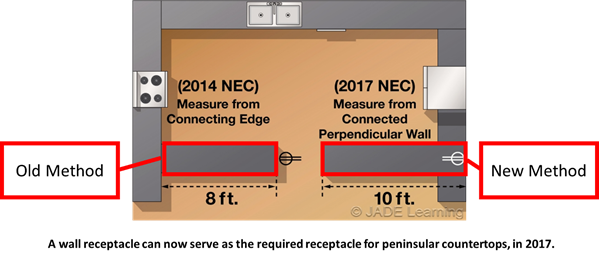NEC 210.52(C)(3) New Peninsular Receptacle Requirements for the 2017 NEC

By: Robert Key | Aug 29, 2019
The method for measuring the countertop space for peninsulas has been changed for 2017. We know that NEC Section 210.52 requires that at least one receptacle be provided for each island or peninsula countertop that fits the dimensional requirements. The intent of the Code here is to discourage the use of extension cords. For example, countertop outlets must be spaced so that the typical two-foot extension cord can reach an outlet from any part of the countertop. Previously, the minimum distance triggering the outlet requirement was measured from the junction where the peninsula abutted the front edge of the perpendicular countertop, thus usually requiring an outlet mounted in the peninsular base cabinet. The new method of measurement begins at the wall behind the countertop.
Why the change?
The purpose is to eliminate all receptacles from the ends and sides of peninsulas. Changing the starting point for the measurement allows the outlet mounted on the wall behind the island to serve as the required outlet.
Why eliminate these side receptacles?
To prevent children from grabbing cords and pulling an appliance down on themselves. You have likely heard tragic news reports where a toddler pulled a deep fryer or coffee maker over on him or herself and was burned severely. Adults are at risk too. Burns are one of the most common injuries sustained in the kitchen, and burns resulting from these types of injuries can be extremely painful, disfiguring, even fatal. It makes sense to trade the risk associated with the presence of the side or end-mounted peninsular outlet for the inconvenience of not having an outlet available at the peninsula. By allowing the receptacle at the perpendicular wall to serve as the required outlet for the peninsula, the Code has effectively eliminated the requirement for outlets on the side or end of the peninsula base cabinet.
At the 2016 meeting where the NEC code making panel (CMP) declared their intent to eliminate all receptacles from the ends and sides of islands and peninsulas, they stopped short of eliminating the requirement for the base cabinet of an island. They did, however, effectively eliminate the outlet requirement for peninsulas. The outlet behind the peninsula in the adjacent wall can now serve as the required outlet because that wall is where the measurement for the peninsula space now starts.
Here is the language from the old (2014 NEC) Code:
NEC 2014 210.52(B)(3) Peninsular Countertop Spaces. At least one receptacle outlet shall be installed at each peninsular countertop space with a long dimension of 600 mm (24 in.) or greater and a short dimension of 300 mm (12 in.) or greater. A peninsular countertop is measured from the connecting edge.
Here is the new (2017 NEC) language:
NEC 2017 210.52(B)(3) Peninsular Countertop Spaces. At least one receptacle outlet shall be installed at each peninsular countertop long dimension space with a long dimension of 600 mm (24 in.) or greater and a short dimension of 300 mm (12 in.) or greater. A peninsular countertop is measured from the connected perpendicular wall.
Changing the way we measure a peninsular countertop may seem like an unusual way to eliminate the required outlet from a peninsula, but it works well. It effectively removes the required outlet for the base cabinet for peninsulas, while still providing an outlet at the adjacent wall. Although this change does not eliminate the risk for an island countertop, it will go a long way in creating a safer kitchen environment.


What if the peninsula is longer then 24 inchs
Great info. Thank you
Peninsula 96”x 30”
Is the outlet at the adjacent wall the only outlet required?